
Traditional display methods, like CRTs, have been present for many decades. They were frequently used in televisions and PC screens. However, CRTs have a shorter duration, generally lasting around 10,000 to 20,000 hours of operation. This means that after a few of years, users may observe a decline in picture clarity, such as dimming or color deformation. In comparison, LED wall panels can last considerably longer, frequently exceeding 50,000 hrs. This extended lifespan means that users can experience reliable performance without the need for regular substitutions.
Another important aspect to take into account is energy efficiency. LED wall panels consume less energy than conventional displays, which not only helps the ecosystem but also lowers electricity costs. For instance, while a CRT screen may use around 100 watts of power, an LED panel can use as few as 30 to 50 W. This difference in energy usage adds to the overall longevity of LED innovation, as reduced energy usage generates less heat. Excess heat can damage electrical parts, leading to a shorter lifespan for conventional screens.
In furthermore to their longer lifespan and energy conservation, LED wall screens also provide superior image quality. They offer more vivid hues and better contrast, making them ideal for multiple uses, from marketing to educational displays. The technology behind LED screens enables for a broader viewing angle, meaning that images remain sharp and lively even when seen from the flank. This is a significant advantage over traditional displays, which frequently experience from hue deformation and reduced brightness at wider angles.
In summary, the durability of LED panel screens compared to traditional display technologies is a crucial aspect for consumers to take into account. With durations that can surpass 50,000 hours, energy efficiency, and wikipedia reference superior image clarity, LED innovation provides many advantages. As innovation continues to progress, LED wall panels are likely to turn even more common in multiple environments. Understanding these differences can help individuals and organizations make better choices when investing in screen innovation, guaranteeing they get the optimal worth for their requirements.